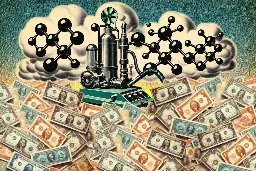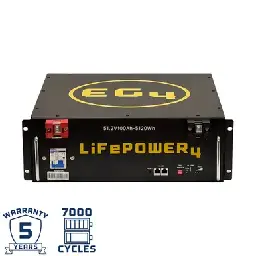
 CadeJohnson @slrpnk.net
CadeJohnson @slrpnk.net retired engineer, former sailor, off grid, gamer, in Puerto Rico. Moderating a little bit.
NYT is spouting every headline they can imagine to shift votes toward Trump, and not just lately. Their entire editorial focus is to cast confusion on Democrats' prospects. They should be recognized as firmly partisan and no longer serving a journalistic purpose. Unfortunate, but that's the times in which we live.
I'd say no in general, but I hold the reins very loosely . . .
There is a new process for treating wastewater sludge that destroys the microfibers, so that is good news at least. I think it may be expensive, of course. It is called "hydrothermal carbonization". Basically put the sludge in a giant pressure-cooker and the heat breaks the plastics into carbon and some water-soluble residual molecules which can go back to the start of the wastewater treatment plant to be biodegraded. But like others say, the main source in general is tires - not sure if they know whether tire microplastics are the main source in agricultural land though.
From the immortal Journal of Irreproducible Results, "The Data Enrichment Method": ". . .its principal shortcoming is that before the enrichment process can be started, some data must be collected. It is quite true that a great deal is done with very little information, but this should not blind one to the fact that the method still embodies the 'raw-data flaw'. The ultimate objective, complete freedom from the inconvenience and embarrassment of experimental results, still lies unattained before us."
Method-neutral carbon removal certification needed
📢📢📢 OpenAir joins 350+ companies and organizations from across the CDR sector to call for a method-neutral EU #CRCF 🇪🇺🇪🇺🇪🇺 docs.google.com/document/d/1...
We are going to need a lot more of this kind of work. I read on permaculture sites about the need to pre-load biochar with nutrients - planting seeded biochar without nutrients could be unproductive. Biochar loading also depends on soil type, how the biochar is made, and how it is applied (tilled in or top-dressed). Size probably matters - big chunks will eventually break apart, but moderate size reduction gives better distribution. Fine dust will not provide the same degree of soil aeration. So, the devil is in the details.
The statistic of low Firefox use is based on accessing US government websites. Could it be that there is significantly LESS government site access by the population of users that prefer Firefox? As a corollary I recently read that game companies observed significantly HIGHER bug reporting from Linux users on Steam, not because there were more Linux-related bugs, but simply because that set of users were more likely to initiate bug reports. Of course Firefox is not Linux and Steam is not the world, but a statistic from a relatively narrow segment of the internet should not be assumed representative of the whole.
Biochar is such an expanding area of investigation, it would be difficult to write a comprehensive book at this point. Of course the root idea of partial-combustion to make soil amendment is well-enough known, but there is much being learned about how to alter the properties of the char by how the pyrolysis is performed. There is much to be learned about how much char to add and how to pretreat the char. Beside burning to make char, there are other ways it can be heated and those affect the type of pyrolysis products that form - molten salt, steam, and subcritical hot water are all gaining prominence. The management and use of the pyrolysis products aside from the char is also a complex topic.
The EU is promising storage will eventually be available — but manufacturers in Europe’s poorer regions are worried it won’t be within reach.

quite a lot of captured CO2 can go into concrete. Maybe a cement (powder) producer is not able to tap into that method directly, but policy shifts will open it up. There are already several US states with low-embodied-carbon concrete laws creating markets for this purpose.
sorry nobody has replied - I'm no help for you from here in Puerto Rico. Are you familiar with the site iNaturalist.org? When we're looking for a species that seems to be missing, we use iNaturalist to check for sightings in the region. You can filter by dates.
I also recently read about "hydrocarbonization" which is another approach for pyrolyzing sewage sludge. Pyrolysis of biomass on a dry basis is often energy-intensive in part because of moisture in the biomass. Nowhere is this more relevant than with sewage sludge, which leaves a wastewater plant at only about 25% solids, typically (though it has a solid appearance like damp clay). If the pyrolysis is performed IN water (which means under pressure if one wants to avoid evaporating the contained water), it can not only still occur, but the water at high temperature and pressure is an active medium for converting some of the biomass into smaller organic molecules.
Upshot is that there is quite a lot of work going on nowadays to be creative with biomass management - that seemed to be of low interest even a decade ago.
Deep sea carbon sequestration with seaweed?
Scientists from the UK’s National Oceanography Centre (NOC), in collaboration with Seafields, Integrated Environmental Solutions (INES) and the
wrong, western philosophy is often based on dichotomies - something is either this or that, but it is more of an analytical tool (I am not nature despite that I am a part of nature). Eastern philosophies are often mystic, though there is western mysticism - that some aspects of existence are incomprehensible on a rational basis and therefore dichotomies are illusory. But such a perspective does not inherently make people better stewards of the environment - in fact they might conclude that their every action is "natural" by definition.
lmao
In the US, stove burners are rated in the confusing units of "BTUs" which is actually a unit of energy, not power. When they say BTU, they mean BTU/hour. The highest-rated burners on a typical stove are about 10,000 Btu (per hour), but high-end stoves can get up to about 18000 - that is equivalent to about 5000 watts. My single-element induction top is only rated for about 1000 watts. So although it heats and cools rapidly, I suspect it is not up to the demands of wok cooking (unless one wants to cook only very small portions).
not Chinese, but I cook a lot with a wok. I also have a single induction cooktop and surprisingly, the wok has enough iron to work with it while some old cheap conventional cookware did not. However, wok cooking needs to be hot all over the wok and not just in that little point where the wok is close enough to the induction coil.
I have a conventional propane stove which I need to keep, because here in Puerto Rico the power system is quite unreliable (especially during a bad hurricane year). But the conventional stove burners are not really hot enough. With a 1/16 - inch drill bit I could increase one of the burners capacity substantially. I painted the stove knob red so people have some warning when they light that burner! It burns more gas, but wok cooking is really fast, so in the long run it is probably more efficient than lots of other cooking approaches.
I would definitely consider a wok-shaped induction heater. Induction heating is quite remarkable.
I'd hate to think modern society is based on a giant elaboration of poker, but I can't rule it out - it MIGHT not be the worst outcome, but a pseudo-equilibrium far from the best. Every young person knows something accessible in the past is now lost to them - not sure what it is, but there is a hole. And yet, the social track laid out is almost unavoidable.
I traveled a good bit the past 20 years and I've experienced first-hand the really hard work and the immense gratification of simple farming. Nobody wants to live like that (at least so they think). Having done it, I can't even say I recommend it over what modern society seems to offer. But since the best option on offer is not a true equilibrium, as the climate is making abundantly clear, what is on offer may be illusory. An alternative equilibrium - tried and true - is worth considering when opportunity arises: subsistence farming. It is NOT simple or easy - don't wait until there is no other option.
OpenAir - This Is CDR Episode 88 - Cascade Climate
OpenAir is excited to present This Is CDR, an online event series that explores the wide range of carbon dioxide removal (CDR) solutions currently being researched, developed, and...

I have heard this, and I can imagine it is true, but have you seen any analysis? There must be a large crew traveling and lots of equipment - transportation is a big user of petroleum in general -- for entertainment. Though they say the entertainment is good.
Swimming pools are normally constructed empty. They were withstanding surrounding soil before they were filled, and concrete strength increases with age (for about 90 days, typically). On the other hand, a sunken structure like a pool that is roofed over, becomes a "confined space". Unlike a typical structure, heavier-than-air gases cannot escape from the pool. Such gases could originate from the drain system or flow from leakage outside the pool area. For examples, leaking propane or various gases from sewer lines in the vicinity. A sunken greenhouse would almost certainly be a building code violation for that reason. If you build it, ventilate it by means both active and passive and do not enter if you can't verify that ventilation is working.
the ultimate run-away train! No matter how impossibly big it is, it just grew infinitely bigger in the past second.
2024 Carbon Removal Challenge - student CDR innovation competition


entry details in the image text. A QR code is provided for a registration link
It is not a surprising situation at this point - oil and gas companies already had a large available supply of CO2 from "sweetening" of natural gas. We have to understand the dramatic difference between "capturing" CO2 - meaning capturing from a point source like a stack or process - and "removing" CO2 - meaning removing it from the atmosphere. In normal use, these terms have such similar meanings that it is very easy for nefarious actors to conflate them. It is very easy for regulators to become confused. It is very easy for the oil and gas industry to take advantage of the situation. I think the key solution is education.
The technology to capture CO2 from industrial streams where it is already concentrated, is quite different that removal. Advances in capture technology are only stop-gap and can be better driven by strong enforcement of ever-tighter emission limits than subsidizing of costs.
Companies capture a lot of CO2. Most of it is going into new oil.
cross-posted from: https://slrpnk.net/post/3903718
> Excerpt: > > > That’s the theory, anyway. But today, the lion’s share of the CO2 captured from industrial processes doesn’t go back into the ground. Instead, 60 percent of it is used to extract more oil, in a controversial process known as “enhanced oil recovery.” > > > > “I think it’s a huge problem,” said Lorne Stockman, research co-director of the advocacy group Oil Change International. “The oil and gas industry has done a very good job of co-opting our climate and clean energy policy.” > > > > For over a decade, the U.S. government has been quietly funding the capture of CO2 that is ultimately used to drill more oil. Some experts and researchers argue that the climate impact is net positive: The oil will be drilled anyway, and the process can help companies learn how to capture CO2 more efficiently. But others say that the government shouldn’t be helping companies sustain more fossil fuel extraction.
maybe space is the graviton field itself(!), but maybe there is a graviton field (or is it the Higgs field?) and gravitons (and Higgs particles?) are excitations of that field; like other particles are excitations of their various postulated quantum fields
According to a new paper in Oxford Open Climate Change, the strategies humanity must pursue to reduce climate change will have to include more than reducing greenhouse gases. This comes from an analysis of climate data led by researcher James Hansen.

CDR is a giant industry in its infancy
Despite major investments from Big Tech and “startling” maturation of CDR technology, mid-century removal targets are far off.

Frogs in the water tanks
My rainwater collection begins with a first-flush and debris removal tank, but it is not ideal; all the water flows through it and in a big rain it can stay stirred up. So it has debris and because it is necessarily open to the roof this means some bugs in there. The outlet to the storage tank is wrapped with three layers of window-screen cloth, but the overflow is open to the drain. Frogs (cute little coqui tree-frogs) come up the drain and inhabit the tank. The storage tank overflow ties into the first flush overflow, so once in a while there is a tree frog in the first storage tank. There are no bugs in that tank so the frog will die if I fail to capture it (which they are very wily).
How can I keep a frog from climbing up the pipe while being sure I do not obstruct water going down the pipe?
magnetohydrodynamics?
has anyone here ever experimented with an "electromagnetic" pump? If the pumped liquid is conductive and the piping is enclosed in a coil (think solenoid), and a current is passed across the fluid near the coil, then the magnetic field made by the coil should attract the fluid passing the transverse current (causing it to flow). As fluid flows toward the coil, new fluid starts passing current and so on.
Electromagnetic pumps are used in metal processing for continuous casting, but those are fancy and expensive devices. Could I pump seawater by wrapping a coil around a garden hose and pop-riveting a couple of electrical contacts into the hose on opposite sides next to the coil? I think regular "fresh" water would not be sufficiently conductive, but whatdoIknow? My longer term plan is to try pumping molten salt, but I want to learn on cooler stuff first.
I'm all ears!
Right now, could you prepare a slice of toast with zero embodied carbon emissions?
This is a bit tangential, but it is a well-framed commentary which applies when we think about CDR.
cross-posted from: https://aus.social/users/ajsadauskas/statuses/111062337668091472
> Right now, could you prepare a slice of toast with zero embodied carbon emissions? > > Since at least the 2000s, big polluters have tried to frame carbon emissions as an issue to be solved through the purchasing choices of individual consumers. > > Solving climate change, we've been told, is not a matter of public policy or infrastructure. Instead, it's about convincing individual consumers to reduce their "carbon footprint" (a term coined by BP: https://amp.theguardian.com/commentisfree/2021/aug/23/big-oil-coined-carbon-footprints-to-blame-us-for-their-greed-keep-them-on-the-hook). > > Yet, right now, millions of people couldn't prepare a slice of toast without causing carbon emissions, even if they wanted to. > > In many low-density single-use-zoned suburbs, the only realistic option for getting to the store to get a loaf of bread is to drive. The power coming out of the mains includes energy from coal or gas. > > But. > > Even if they invested in solar panels, and an inverter, and a battery system, and only used an electric toaster, and baked the loaf themselves in an electric oven, and walked/cycled/drove an EV to the store to get flour and yeast, there are still embodied carbon emissions in that loaf of bread. > > Just think about the diesel powered trucks used to transport the grains and packaging to the flour factory, the energy used to power the milling equipment, and the diesel fuel used to transport that flour to the store. > > Basically, unless you go completely off grid and grow your own organic wheat, your zero emissions toast just ain't happening. > > And that's for the most basic of food products! > > Unless we get the infrastructure in place to move to a 100% renewables and storage grid, and use it to power fully electric freight rail and zero emissions passenger transport, pretty much all of our decarbonisation efforts are non-starters. > > This is fundamentally an infrastructure and public policy problem, not a problem of individual consumer choice. > > \#ClimateChange #urbanism #infrastructure #energy #grid #politics #power @green
How big will the CDR effort become?
There is a big difference between the CDR needed to reach net zero, for neutralizing methane, and removals to bring back down temperatures after overshoot.

tldr several BILLION tons per year by 2050! Roughly equivalent to the total mass of all the cars in the world - every year.
Northern Bishop


At Laguna Cartagena, near Cabo Rojo, Puerto Rico (red bird with black chest and mask, perched on green leaves, lit by sunrise)
Is there a list of carbon sequestration projects?
cross-posted from: https://mander.xyz/post/2421501
> There seems to be a huge number of miscellaneous projects for a specific type of environmental restoration or some other activity that is specifically aimed at carbon sequestration. For example, seagrass restoration alone has a plethora(1,2,3). Is there a decent list of these projects? I found this cool list of CCS projects(4), but that’s different. > > If such a list exists, I have another question: Is there an objective way to compare their effectiveness? > > https://www.projectseagrass.org > > https://www.medseafoundation.org/index.php/en/portfolio-ita-2/a-sea-forest-to-save-the-planet/34 > > https://www.seegraswiesen.de/en/ > > https://en.m.wikipedia.org/wiki/List_of_carbon_capture_and_storage_projects
The featured house
This is a video of my off-grid house in the Dominican Republic, which is featured in this community's title background. It is for sale, so buy it and you can be famous! lolz https://drive.google.com/file/d/16s22L6fgJRtxPQ-a6_aEWy8QJsgsWexN/view?usp=sharing
Prominent academics, including a former IPCC chair, round on governments worldwide for using the concept of net zero emissions to ‘greenwash’ their lack of commitment to solving global warming.

Net Zero is when the bathtub quits overflowing, CDR is how we mop up the water and pump out the flooded basement.
Please don't forget, there are other places than the US for living off-grid too.
Overconnected? Want to grow your own crops? Unplug from it all in one of the Best States to Live Off the Grid.

very good battery price
EG4 (48V/100AH) LifePower4 Battery EG4 Lithium battery 51.2V (48V) 5.12kWh with 100AH internal BMS. Made of UL Listed Battery Cells. Off Grid Solar Batteries - Off Grid System - Solar Batteries for Home - Lithium Solar Batteries - Deep Cycle Solar Batteries - Power Reserve - Solar Panels Plus Batter...

These EG4 batteries from Signature Solar look like a pretty good deal to me; $265/kWh according to their calculation. I paid a little over $500/kWh for some 12V form-factor lithium batteries at the start of the year and thought those were a reasonable price.
At first Adam Smith couldn’t believe his calculations. Then it sank in.

cross-posted from: https://beehaw.org/post/2196737
> Like many of you, birds are very special to me. I connect with them like I don’t any other living creature, save my wife and kids. I photograph them. I’ve covered my body in nothing but bird tattoos. > > To see that a THIRD of them have disappeared is like a knife to the heart.
Off grid power fun
Today's adventure: a couple of rainy days caused low battery levels, but not too low I thought - still 30% or so; these are lithium batteries and can deep cycle. They are "smart" batteries and if one is full in series, none can charge further - so they should all be at the same charge level all the time. But a couple had gotten out of step somehow and when they reached zero everything shut down.
How to bootstrap it? With no battery output (since a zero battery turned itself off and would not let the battery bank show any voltage!) - there is no way to activate the inverter and let street power run the battery charger. With no battery power, there is no way to turn on the MPPT controller and charge the batteries!
I could rearrange the banks to put four batteries with remaining charge in series because I have an 8-battery system, and get things restarted; but if there had been only four like when I first installed the system - I'd be in trouble.
Another thing that happened. Before I figured out the battery problem, I was trying to switch back to street-power. Because power from the street comes to the inverter first and then the inverter powers the distribution panel, when the batteries are down, I cannot get street power to the distribution panel. I could install a manual bypass, but it is not a commonly needed item and it is a large amp switch. So I removed the inputs and outputs at the inverter and bypassed manually. That worked fine. But in the process of disconnecting or reconnecting, I must have loosened the neutral connection to the inverter. So when the inverter was working again and I checked voltage, I only checked across the two hot legs - yay, 240V. I did not check that each leg was 120v from neutral! They were not: one leg was at zero and the other was at 240. I found this discrepancy fairly quickly after only destroying an outlet strip, the oven control electronics from a very old stove we were wanting to replace, and the controls of an old Sharp microwave oven with the 4, 7, 9 and Clear buttons not working. Woohoo we have a new stove out of the deal!